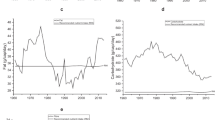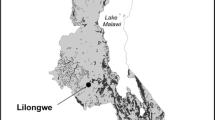Abstract
An analytical framework is described for assessing the nutritional adequacy of national food supplies and the potential for addressing micronutrient gaps by increased crop production and crop diversity. The micronutrient contents of national food supplies of three countries (Bangladesh, Senegal, and Cameroon) were estimated using data from national food balance sheets. Population-adjusted nutrient requirements and identified nutrient short-falls, defined as not meeting the requirements of at least 80 % of the population, were also estimated. Linear programming models were used to determine a mix of crops that could meet the gaps the deficits of several nutrients while minimizing the use of additional agricultural land. Out of eight micronutrients included in the present analysis, six were identified as inadequate in Bangladesh and Senegal (vitamins A and C, riboflavin, folate, calcium, and zinc) and three were inadequate in Cameroon (vitamin A, calcium, and zinc). Adequacy of vitamins A and C could be met by increasing production of a few crops that are particularly dense in these nutrients (e.g., carrots or guava), which would necessitate only a small addition of agricultural land. Folate adequacy could be improved with increased production of legumes and green leafy vegetables, but with a greater requirement for agricultural land. Some micronutrient gaps, however, would probably have to be met by other means, such as enhanced livestock production, food fortification, biofortification, or imports. Despite the limitations of agriculture to meet the entire nutrient needs of a population, agricultural policy should consider the potential to improve nutrient adequacy with the crops currently available and by crop diversification.
Similar content being viewed by others
References
Arsenault, J. E., Yakes, E. A., Islam, M. M., Hossain, M. B., Ahmed, T., Hotz, C., et al. (2012). Very low adequacy of micronutrient intakes by young children and women in rural Bangladesh is primarily explained by low food intake and limited diversity. Journal of Nutrition, 143(2), 197–203.
Black, R. E., Victora, C. G., Walker, S. P., Bhutta, Z. A., Christian, P., de Onis, M., et al. (2013). Maternal and child undernutrition and overweight in low-income and middle-income countries. Lancet, 382(9890), 427–451.
Calloway, D. H., Murphy, S. P., Beaton, G. H., & Lein, D. (1993). Estimated vitamin intakes of toddlers: predicted prevalence of inadequacy in village populations in Egypt, Kenya, and Mexico. American Journal of Clinical Nutrition, 58, 376–384.
Engel-Stone, R., Haskell, M. J., Ndejebayi, A. O., Nankap, M., Erhardt, J. G., Gimou, M., et al. (2011). Plasma retinol-binding protein predicts plasma retinol concentration in both infected and unifected Cameroonian women and children. Journal of Nutrition, doi: 10.3945/jn.111.145805 . Epub 2011 Nov 2.
Engel-Stone, R., Ongla Ndjebayi, A., Nankap, M., & Brown, K. H. (2012). Consumption of potentially fortifiable foods by women and young children varies by ecological zonc and socio-econmic status in Cameroon. J of Nutrition, 142(3), 555–565.
Engel-Stone, R., Ndejebayi, A. O., Nankap, M., Killilea, D. W., & Brown, K. H. (2014). Stunting prevalence, plasma zinc concentrations, and dietary zinc intakes in a nationally representative sample suggest a high risk of zinc deficiency among women and young children in Cameroon. Journal of Nutrition, 10.3945/jn.113.188383 . Epub 2014 Jan 22.
Fanzo, J., Hunter, D., Borelli, T., & Mattei, F. (Eds.). (2013). Diversifying food and diets: using agricultural biodiversity to improve nutrition and health. London and New York: Routledge.
FAO. (2001). Food balance sheets: A handbook. Food and Agriculture Organization (FAO): Rome.
FAO (2009). Food Balance Sheets. http://faostat.fao.org/site/354/default.aspx. Accessed August 8 2013.
FAO. (2012). West African Food Composition Table. Rome: Food and Agriculture Organization.
FAO (2014). FAOSTAT Glossary. http://faostat.fao.org/site/375/default.aspx. Accessed March 17 2014.
Frison, E. A., Smith, I. F., Johns, T., Cherfas, J., & Eyzaguirre, P. B. (2006). Agricultural biodiversity, nutrition, and health: making a difference to hunger and nutrition in the developing world. Food and Nutrition Bulletin, 27(2), 167–179.
Global Alliance for Nutrition (2013). Fortification in edible oil with vitamin A bill, 2013. http://www.gainhealth.org/press-releases/fortification-edible-oil-vitamin-bill-2013. Accessed October 1 2014.
International Zinc Nutrition Consultative Group (IZiNCG), Brown, K. H., Rivera, J. A., Bhutta, Z., Gibson, R. S., King, J. C., et al. (2004). International Zinc Nutrition Consultative Group (IZiNCG) technical document #1. Assessment of the risk of zinc deficiency in populations and options for its control. Food and Nutrition Bulletin, 25(1), S99–S203.
Iannotti, L., Cunningham, K., & Ruel, M. T. (2009). Improving diet quality and micronutrient nutrition. Homestead food production in Bangladesh. IFPRI Discussion Paper 00928. Washington, DC: International Food Policy Research Institute.
icddr, b., UNICEF, B., GAIN, & Institute of Public Health and Nutrition (2013). National Micronutrients Status Survey 2011–12. Bangladesh: icddr,b.
The Micronutrient Initiative& UNICEF. (2004). Vitamin and mineral deficiency: a global damage assessment report. Ottowa, Canada: Micronutrient Initiative.
Institute of Medicine. (2000). Dietary reference intakes: applications in dietary assessment. Washington, DC: The National Academies Press.
Institute of Medicine. (2006). Dietary reference intakes: the essential guide to nutrient requirements. Washington, DC: The National Academies Press.
Site and Life (2013). Food Fortification in Africa: Progress to date and priorities moving forward. http://www.sightandlife.org/fileadmin/data/Magazine/2013/27_3_2013/food_fortification_in_africa.pdf. Accessed October 1 2014.
Meisner, C., Welch, R., Duxbury, J. M., & Lauren, J. G. (2005). Making a greener revolution: a nutrient delivery system for food production to address malnutrition through crop science. Plant Production Science, 8(3), 326–329.
Moltedo, A., Troubat, N., Lokshin, M., & Sajaia, Z. (2014). Analyzing food security using household survey data: Streamlined analysis with ADePT software. Washington, DC: World Bank.
Murphy, S. P., Beaton, G. H., & Calloway, D. H. (1992). Estimated mineral intakes of toddlers: predicted prevalence of inadequacy in village populations in Egypt, Kenya, and Mexico. American Journal of Clinical Nutrition, 56, 565–572.
Nelson, M., Black, A. E., Morris, J. A., & Cole, T. J. (1989). Between- and within-subject variation in nutrient intake from infancy to old age: estimating the number of days required to rank dietary intakes with desired precision. American Journal of Clinical Nutrition, 50, 155–167.
U.S. Department of Agriculture (1975). Agriculture Handbook No. 102. Food yields summarized by different stages of preparation. Beltsville, MD.
U.S. Department of Agriculture (2013). USDA National Nutrient Database for Standard Reference, Release 26. Beltsville, MD: Nutrient Data Laboratory Home Page, http://www.ars.usda.gove/ba.bhnrc/ndl.
United Nations Department of Economic and Social Affairs, Population Division, & Population Estimates and Projections Section (2012). World Population Prospects: The 2012 Revision. http://esa.un.org/unpd/wpp/ASCII-Data/DISK_NAVIGATION_ASCII.htm. Accessed 1 Aug 2013.
University of California at Berkeley International Minilist. WorldFood Dietary Assessment System, 2nd edition. http://www.fao.org/infoods/software_worldfood_en.stm. Accessed 1 Sep 2006.
Wessells, K. R., Singh, G. M., & Brown, K. H. (2012). Estimating the global prevalence of inadequate zinc intake from national food balance sheets: effects of methodological assumptions. PLoS ONE, 7(11), e50565.
Willett, W. C., Sampson, L., Stampfer, M. J., Rosner, B., Bain, C., Witschi, J., et al. (1985). Reproducibility and validity of a semiquantitative food frequency questionnaire. American Journal of Epidemiology, 122, 51–65.
Acknowledgments
The authors thank Shawn Baker and Shelly Sundberg of the Bill and Melinda Gates Foundation for their insightful comments of a draft version of the manuscript.
Conflict of Interest
The authors declare that they have no conflict of interest.
Author information
Authors and Affiliations
Corresponding author
Rights and permissions
About this article
Cite this article
Arsenault, J.E., Hijmans, R.J. & Brown, K.H. Improving nutrition security through agriculture: an analytical framework based on national food balance sheets to estimate nutritional adequacy of food supplies. Food Sec. 7, 693–707 (2015). https://doi.org/10.1007/s12571-015-0452-y
Received:
Accepted:
Published:
Issue Date:
DOI: https://doi.org/10.1007/s12571-015-0452-y




